Articles
- Page Path
- HOME > J Korean Acad Nurs > Volume 39(5); 2009 > Article
-
Original Article
- Use of Physical Assessment Skills and Education Needs of Advanced Practice Nurses and Nurse Specialists
- Hyunsook Shin, Bog-Ja Kim, Hee Sun Kang
-
Journal of Korean Academy of Nursing 2009;39(5):709-719.
DOI: https://doi.org/10.4040/jkan.2009.39.5.709
Published online: October 31, 2009
1Assistant Professor, College of Nursing Science East-West Nursing Research Institute, KyungHee University, Korea.
2Clinical Assistant Professor, Department of Nursing, College of Medicine, University of Ulsan, Korea.
3Associate Professor, Department of Nursing, Chung-Ang University, Seoul, Korea.
- Address reprint requests to: Kang, Hee Sun. Department of Nursing, College of Medicine, Chung-Ang University, 221 Heukseok-dong, Dongjak-gu, Seoul 156-756, Korea. Tel: 82-2-820-5699, Fax: 82-2-824-7961, goodcare@cau.ac.kr
Copyright © 2009 Korean Society of Nursing Science
Abstract
-
Purpose
- The study was done to investigate physical assessment skills used by, and educational needs of, advanced practice nurses (APNs) and nurse specialists in Korea.
-
Methods
- A total of 123 APNs and nurse specialists working in five major hospitals in Seoul were surveyed from July 15 to August 20, 2007.
-
Results
- Fourteen skills out of 126 items were reported as being performed on a regular basis by participants. The majority of these skills involved general observation. Forty-six skills were rarely used. Some participants showed a lack of confidence in certain assessment skills, such as in doing a rectal or pelvic exam, and the use of some assessment equipment. Over 90% of participants required in-depth education on health assessment provided by specialists or nursing professional organizations.
-
Conclusion
- More educational opportunities in physical assessment should be provided including education programs based on the nurses' skill levels and needs. This effort will help to increase confidence of APNs and nurse specialists in physical assessment skills, ultimately resulting in better nursing outcomes.
- 1. Furfaro T, Bernaix L, Schmidt C, Clement J. Nurse practitioners' knowledge and practice regarding malignant melanoma assessment and counseling. Journal of the American Academy of Nurse Practitioners. 2008;20:367–375.ArticlePubMed
- 2. Giddens JF. A survey of physical assessment techniques performed by RNs: Lessons for nursing education. Journal of Nursing Education. 2007;46:83–87.ArticlePubMed
- 3. Han SS, Kang HY, Koh MS, Kim KJ, Kim SS, Kim YS, et al. Advanced Practice Nursing. 2005;Seoul, Hyunmoon Publishing Co.
- 4. Joel LA. Advanced practice nursing: Essentials for role development. 2009;2nd ed. Philadelphia, PA, F. A. Davis Com.
- 5. Kelley FJ, Kopac CA, Rosselli J. Advanced health assessment in nurse practitioner programs: Follow-up study. Journal of Professional Nursing. 2007;23:137–143.ArticlePubMed
- 6. Kim H, You S, Kim M, Park C. Direct care stress and job satisfaction in home care nurses. Korean Journal of Women's Health Nursing. 2004;10:261–265.ArticlePDF
- 7. Kim JW. The analysis of wound ostomy continence nursing education program in Korea. 2008;Seoul, Korea University. Unpublished doctoral dissertation.
- 8. Kim SS, You OS, Kwon IG, Moon SM, Sung YH. Development of classification system for critical care and core competencies of advanced practice nurse. Clinical Nursing Research. 2005;11:165–177.
- 9. Korean Accreditation Board of Nursing. Advanced Practice Nurses' core competency and roles in specialties. 2005;Retrieved September 11, 2007. from http://www.kabon.or.kr/.
- 10. Korean Accreditation Board of Nursing. Advanced Practice Nurses' core competency and roles in specialties. 2008a;Retrieved May 18, 2009. from http://www.kabon.or.kr/kabon04/index03.php.
- 11. Korean Accreditation Board of Nursing. Result of survey on Advanced Practice Nurses' work status. 2008b;Seoul, Korean Accreditation Board of Nursing.
- 12. Korean Accreditation Board of Nursing. Advanced Practice Nurses' core curriculum and standardized curriculum. and roles in specialties. 2009;Retrieved May 18, 2009. from http://www.kabon.or.kr/kabon03/index03_02.php.
- 13. Korean Nurses Association. Report on legalization process of Advanced Practice Nurse in Korea. 2001;Retrieved September 11, 2007. from http://www.koreanurse.or.kr/.
- 14. Kwon IG, Kim YH, Hwang KJ, Kim HS, Lee BS, Lee HS, et al. A survey on the role and present state of advanced practice nurses in Korea. Clinical Nursing Research. 2003;9:55–75.
- 15. Lee JH, Sung YH, Yi YH, Cho YA, Kwon IG. The role analysis of intensive care unit nurse and critical care advanced practice nurse. Clinical Nursing Research. 2007;13:93–108.
- 16. Lynn M. Determination and quantification of content validity. Nursing Research. 1986;35:382–385.PubMed
- 17. O'Farrell B, Ford-Gilboe M, Wong C. Evaluation of an advanced health assessment course for acute care nurse practitioners. Canadian Journal of Nursing Leadership. 2000;13(3):20–27.Article
- 18. Oh K, Kim KM, Kim KS, Park JW, Sung MS, Oh EG, et al. Educational issues and strategies to improve APN education. Journal of Korean Academy of Nursing. 2007;37:801–809.ArticlePubMedPDF
- 19. Oliveria SA, Christos PJ, Marghoob AA, Halpern AC. Skin cancer screening and prevention in the primary care setting. Journal of General Internal Medicine. 2001;16:297–301.ArticlePubMedPMC
- 20. Park YA. Development of job standards for neonatal nurse practitioner in Korea. Clinical Nursing Research. 2007;13:127–141.
- 21. Pulcini J, Wagner M. Nurse practitioner education in the United States: A success story. Clinical Excellence for Nurse Practitioners. 2002;6(2):51–56.
- 22. Ryu HS, Oh PJ, Lim JY, Kang HS, Yang SH, Seomun G, et al. Needs of training programs for practice courses in advanced practice nurse education. Journal of Korean Academy of Nursing Administration. 2007;13:553–561.
- 23. Scherer YK, Bruce SA, Montgomery CA, Ball LS. A challenge in academia: Meeting the healthcare needs of the growing number of older adults. Journal of the American Academy of Nurse Practitioners. 2008;20:471–476.ArticlePubMed
- 24. Seidel HM, Ball JW, Dains JE, Benedict GW. Physical examination. 1999;4th ed.New York, NY, Mosby.
- 25. Spain MP, DeCristofaro C, Smith CA. Educating advanced practice nurses for collaborative practice in the multidisciplinary provider team. Journal of the American Academy of Nurse Practitioners. 2004;16:535–546.ArticlePubMed
- 26. Theroux R, Pearce C. Graduate students' experience with standardized patients as adjuncts for teaching pelvic examinations. Journal of the American Academy of Nurse Practitioners. 2006;18:429–435.ArticlePubMed
- 27. Ward H, Barratt J. Assessment of nurse practitioner advanced clinical practice skills: Using the objective structured clinical examination (OSCE). Primary Health Care. 2005;15(10):37–41.Article
- 28. West SL. Physical assessment: Whose role is it anyway? Nursing in Critical Care. 2006;11(4):161–167.ArticlePubMed
- 29. Yawn BP, Wollan PC. Knowledge and attitudes of family physicians coming to COPD continuing medical education. International Journal of Chronic Obstructive Pulmonary Disease. 2008;3:311–317.PubMedPMC
- 30. Yoo MS, Yoo IY. Effects of OSCE method on performance of clinical skills of students in fundamentals of nursing course. Journal of Korean Academy of Nursing. 2003;33:229–235.
REFERENCES
Figure & Data
REFERENCES
Citations

- Experiences of Advanced Health Assessment Simulation Based on the Education Needs of Gerontological Nurse Practitioner Students
Jiyoung Kim, Hyunju Dan
Healthcare.2023; 11(8): 1162. CrossRef - Physical examination competence as a predictor of diagnostic reasoning among new advanced practice nurse students: a cross-sectional study
Hyejung Lee, Young Joo Lee, JuHee Lee, Sanghee Kim
Contemporary Nurse.2019; 55(4-5): 360. CrossRef - Hemşirelerin Fiziksel Değerlendirme Becerileri ve Uygulamaya İlişkin Görüşleri
Banu Çevik, Ziyafet Uğurlu, Elif Akyüz, Sultan Kav, Asuman Ersayın
Hacettepe Üniversitesi Hemşirelik Fakültesi Dergisi.2018; 5(1): 39. CrossRef - Perceived Competency, Frequency, Training Needs in Physical Assessment among Registered Nurses
Heeyoung Oh, Jiyeon Lee, Eun Kyung Kim
Korean Journal of Adult Nursing.2012; 24(6): 627. CrossRef - Development and Validation of a Tool for Evaluating Core Competencies in Nursing Cancer Patients on Chemotherapy
Sung Hae Kim, Jae Hyun Park
Journal of Korean Academy of Nursing.2012; 42(5): 632. CrossRef
General and Work-related Characteristics of Participants (N=123)
APN=advanced practice nurse.
Physical Assessment Skills Used on a Regular Basis (N=123)
*Items added when additional analysis by specialty was performed.
PA=physician assistant; CNS=clinical nurse specialist; APN=advanced practice nurse; CN=cranial nerve.
Physical Assessment Skills Rarely Used (N=123)
CN=cranial nerve; HEENT=head, eye, ear, nose and throat.
Physical Assessment Areas Which Respondents Do Not Know How to Perform (N=123)
PA=physician assistant; CNS=clinical nurse specialist; APN=advanced practice nurse.
Needs for In-Depth Education
*Multiple response; HEENT=head, eye, ear, nose and throat; MRI=magnetic resonance imaging.
APN=advanced practice nurse.
*Items added when additional analysis by specialty was performed. PA=physician assistant; CNS=clinical nurse specialist; APN=advanced practice nurse; CN=cranial nerve.
CN=cranial nerve; HEENT=head, eye, ear, nose and throat.
PA=physician assistant; CNS=clinical nurse specialist; APN=advanced practice nurse.
*Multiple response; HEENT=head, eye, ear, nose and throat; MRI=magnetic resonance imaging.
 KSNS
KSNS
 E-SUBMISSION
E-SUBMISSION
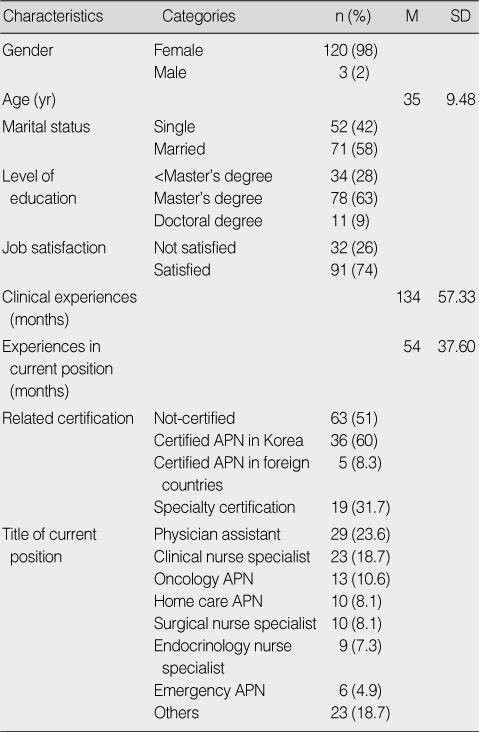
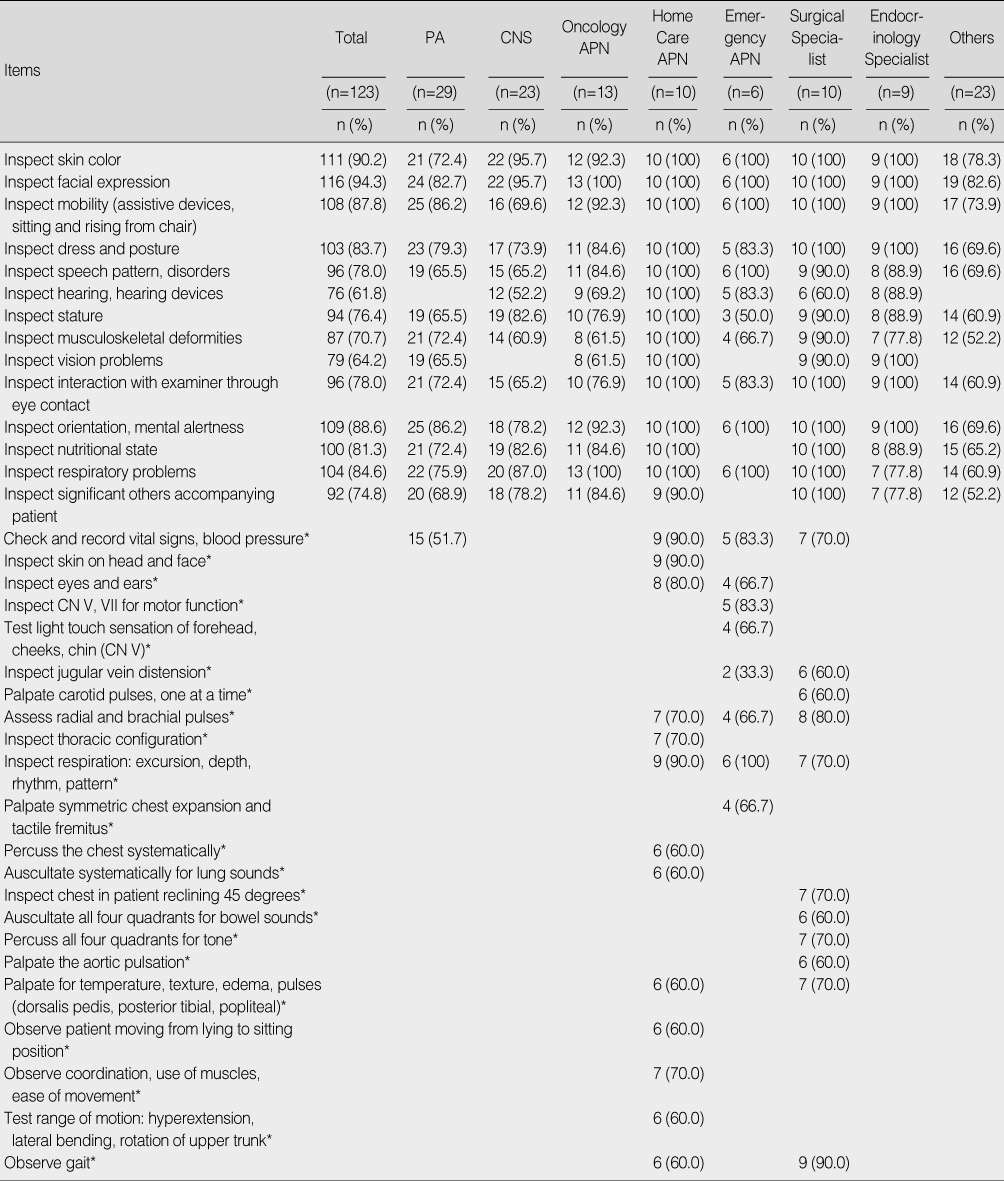
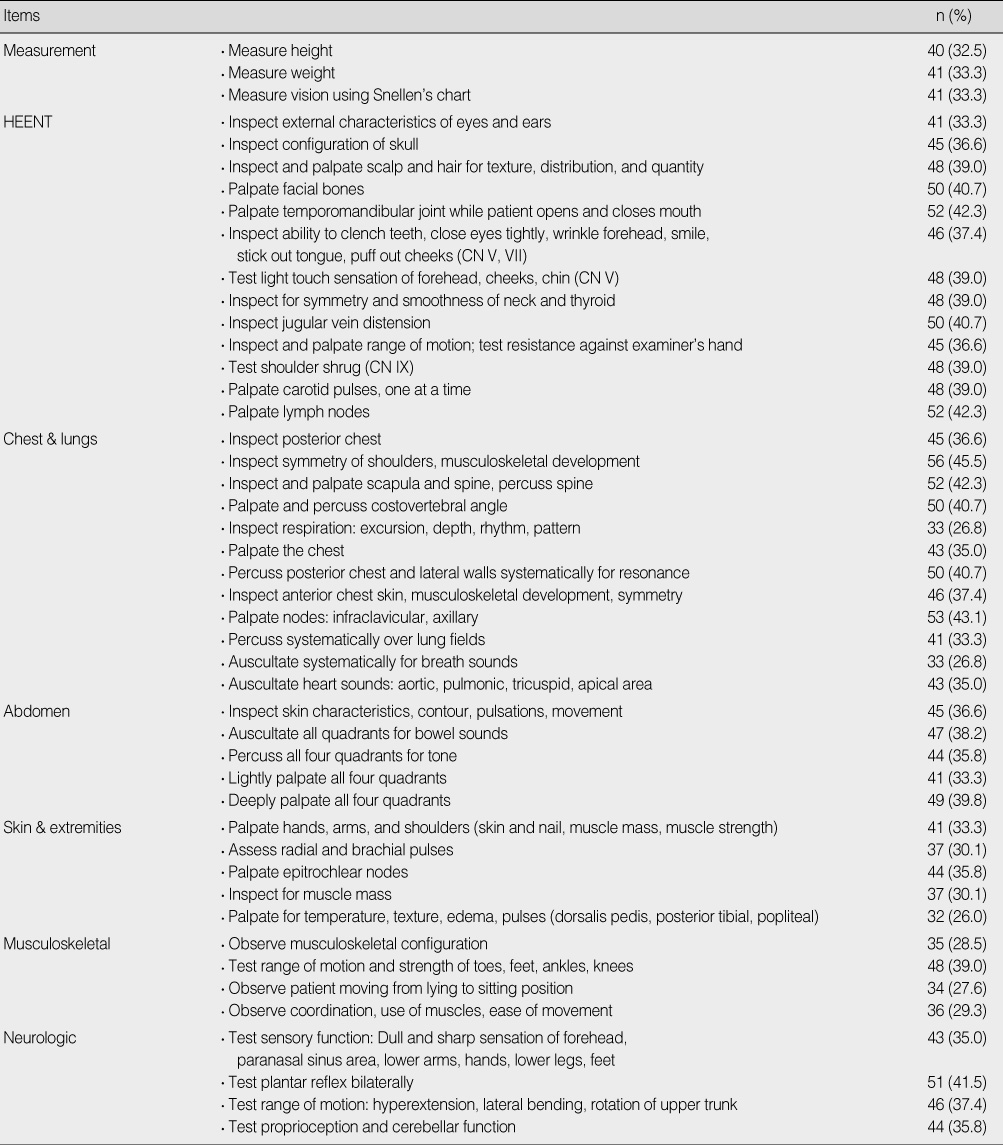
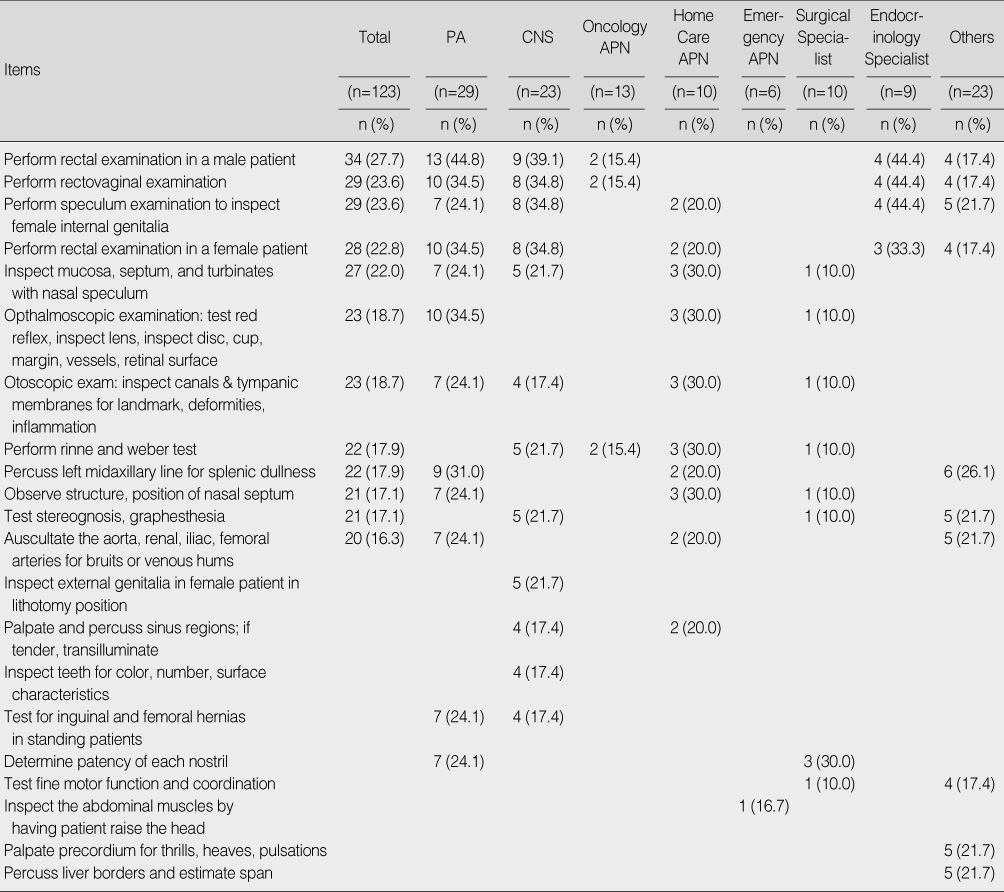
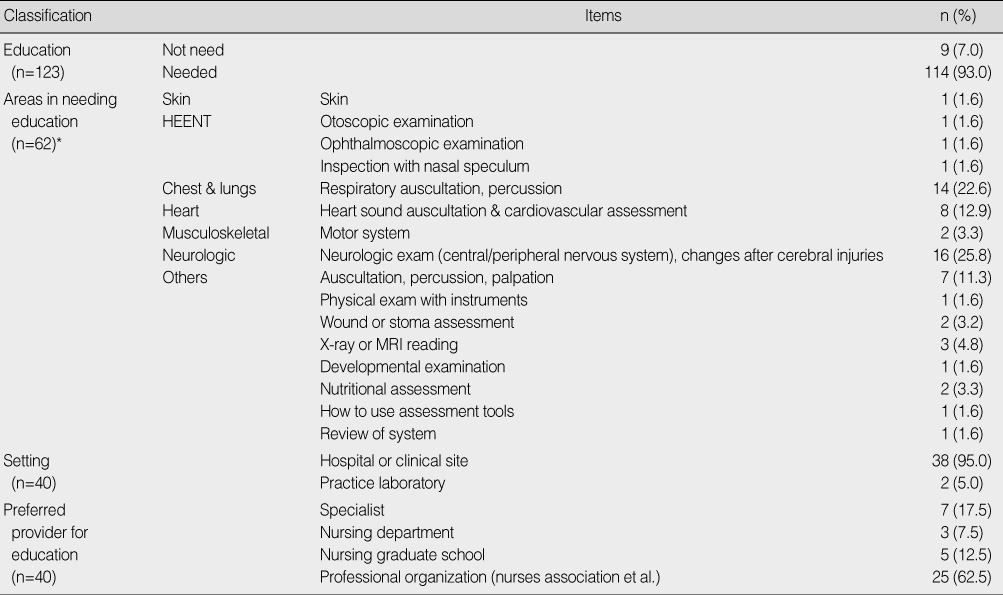
 Cite
Cite

